Original author: Yilan, LD Capital
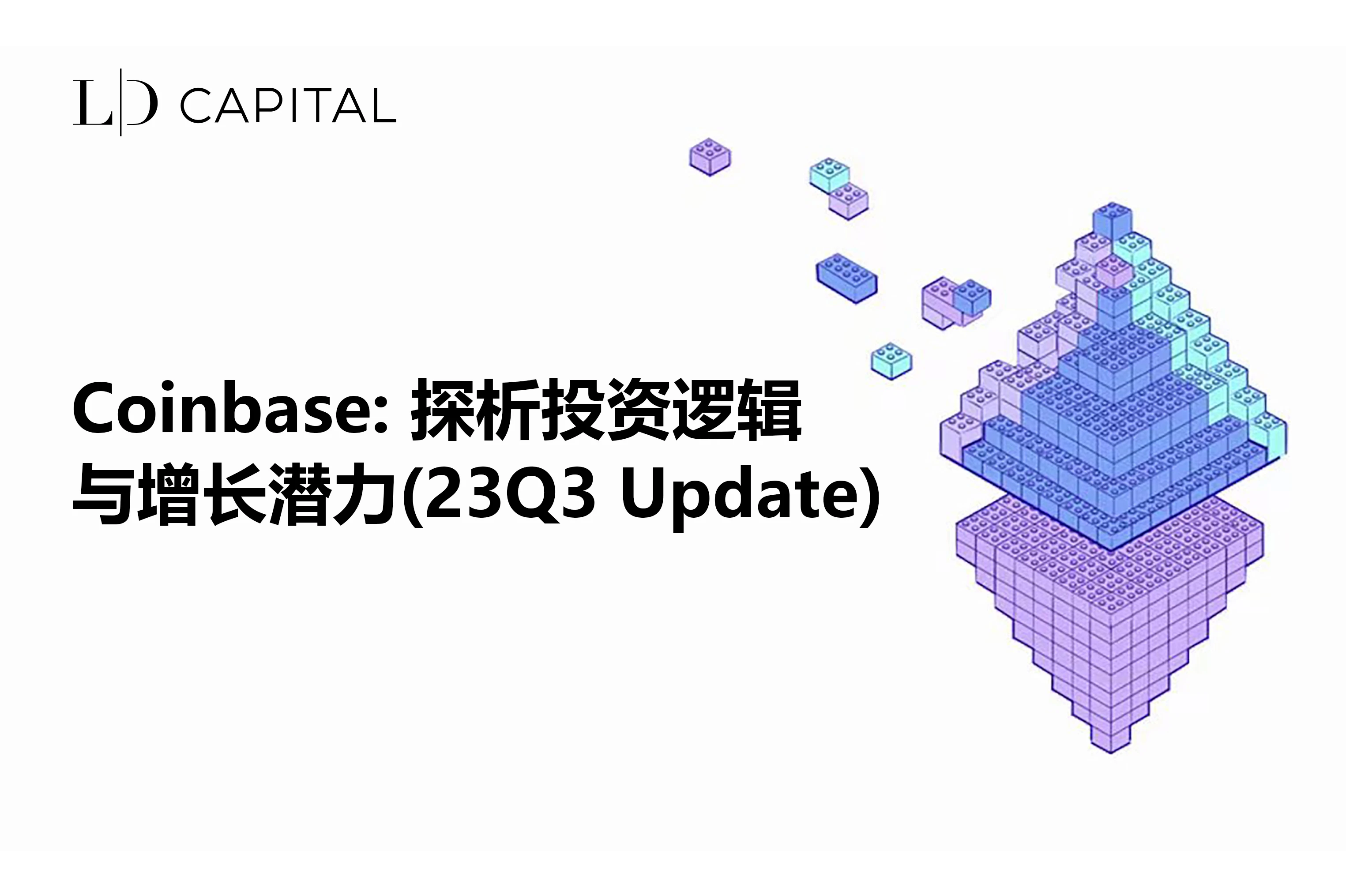
one. Investment logic
1. Asset Class-U.S. Stock Compliance Crypto Market Exposure Target
Coinbase stock is up more than 173% this year, with gains attributed to Bitcoins 122% gain since the beginning of the year and a 40% gain in technology stocks. Following the U.S. stock market and the crypto market simultaneously, this dual-market correlation will bring benefits beyond both markets when the trend is upward.
The picture shows the correlation between COIN and ETH and other related assets (MARA, HUT, GLXYCOIN, MSTR, etc.), which are all targets that closely follow the trend of ETH.
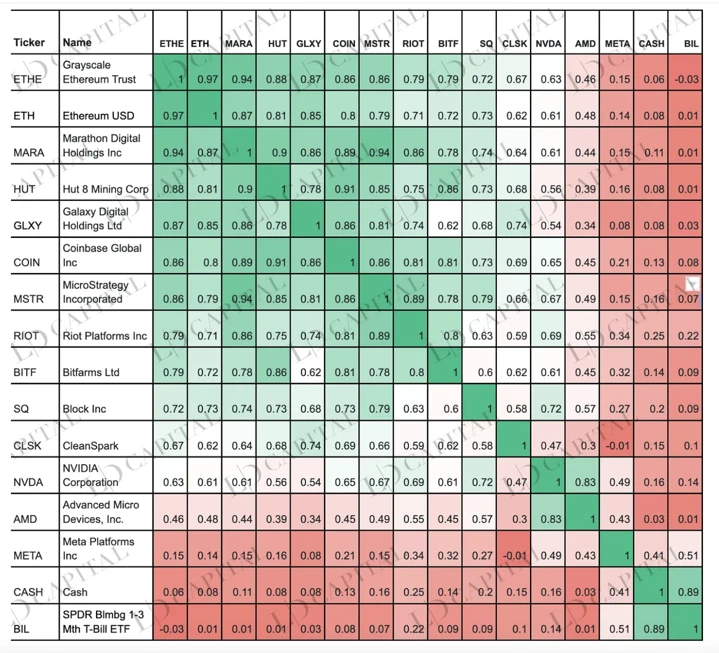
Source:LD Capital
2. The growth potential of the main business has not yet been released
Coinbases main business is trading income. Recently, due to the positive impact of the macroeconomic cessation of interest rate hikes and industry cyclical halving events, as well as market speculation caused by events such as spot ETFs, market expectations are relatively positive, and Coinbases stock price has performed strongly. However, the continuation of the high inflation and high interest rate environment suitable for the growth of cryptography in the next 8-12 months will still have a negative impact on Coinbase’s main business.
For Coinbase, which has only been listed in May 2021 and has encountered a bear market, growth is the core driver of the rise in stock prices. Coinbases global station and derivatives trading were only officially launched in May this year. The global station will bring more spot trading volume. Derivatives business is a huge driver of increased trading revenue. On August 14, Coinbase announced its official entry into Canada, launching alongside Interac payment rails, other partnerships, fund transfers, and Coinbase One, which shows Coinbase’s emphasis on growth (regional and business expansion). Therefore, although business growth in the next 12 months is limited by external conditions, combined with many unrealized benefits, the potential for revenue growth within 24 months is huge.
3. Total transaction volume did not meet expectations but adjusted EBITDA continued to exceed expectations.
Coinbase 2023 achieved an adjusted EBITDA of 180 million in the third quarter. Although it was not as good as the 194 million in the second quarter, it still exceeded expectations. Compared with the same period last year, the decline in trading volume was mainly due to a 60% drop in crypto asset volatility. Therefore, the market Although Coinbase has poor profit expectations, in fact, Coinbase performed well in Q3, achieving a net profit of 81.6 million yuan through repurchasing notes at a discount. And due to the positive impact of the macro environment on the positive expectation of no more interest rate hikes, Coinbase has experienced a much higher-than-expected adjusted EBITDA due to the combination of profits from strategic bond repurchases and favorable macro fundamentals, and is expected to achieve this in the fourth quarter. Positive EBITDA.
4. Coinbase vigorously develops subsidiary businesses to bring new performance growth points
· International station and derivatives trading business - Coinbases derivatives exchange is indeed still in its early stages. Q2-Q3 actually only launched an API beta version and only had a few customers. Therefore, some of the next steps Coinbase will take include integrating it into retail applications. In August, its wholly-owned subsidiary CFM successfully obtained regulatory approval from the National Futures Association (NFA), a self-regulatory organization designated by the U.S. Commodity Futures Trading Commission (CFTC), to become a futures broker (FCM), allowing it to sell qualified U.S. customers Offers federally regulated cryptocurrency futures trading. The official launch of the international station and derivatives products will bring substantial revenue growth.
· USDC Business - Coinbase acquires a minority stake in Circle, without disclosing specific figures regarding the investment. The nature of this investment means Coinbase and Circle will have greater strategic and economic alignment on the future development of the financial system. It indicates that USDC will have broader development prospects and may expand from cryptocurrency trading to areas such as foreign exchange and cross-border transfers. Coinbase’s senior executive downplays competition with PayPal’s entry into the stablecoin space (PYUSD 44 mln Supply still has a small market share). The increase in Q3 stablecoin revenue was mainly attributed to higher average interest rates on USDC reserves, which rose by 375 basis points or 420%. Coinbase and Circle will continue to generate revenue from interest earned on USDC reserves.
· On-chain business - After Base goes online, the additional sorting MEV income will be the direct profit that Coinbase can obtain. In addition to direct profit opportunities, Coinbase CFO Alesia said in the conference call that the usage of Base will bring all the benefits provided by Coinbase. Other product and service opportunities, such as users using Coinbases payment channels and wallet products, will also generate ancillary revenue. In addition, the ETH staking business has brought at least US$100 million in revenue to Coinbase.
5. Coinbase may continue to gain more market share than Binance and become the largest exchange
The SEC’s charges against Binance are more serious. In addition to being accused of operating an unregistered stock exchange, brokerage, and clearing agent like CB, the SEC also accused it of engaging in more FTX-like activities: deception, mixing assets across entities, and communicating with customers. The SEC did not bring similar charges against Coinbase for conducting counterparty trading. The global suppression of rival Binance is good for Coinbase, which means that Coinbase is likely to replace Binance as the most influential exchange.
6. Having the necessary compliance qualifications makes Coinbase one of the biggest beneficiaries of Spot ETFs
After the traditional asset management institutions spot ETF application is approved, it will be a huge benefit to Coinbase as a potential custodian. Coinbase will obtain its main income from hosting the upcoming spot ETF through AUCC (annual average asset cost under custody). In the future it is thought that there will be a lot of additional income from clearing and other services. But there are still many problems that need to be solved before that, and there is a long time window.
7. Regulatory pressure increases compliance costs
While Coinbase has performed well during the ongoing crypto winter, ongoing regulatory uncertainty remains the basis for a negative outlook for the company. Regarding the SEC’s lawsuit against Coinbase, Coinbase is seeking to dismiss a lawsuit filed by the SEC in June accusing the company of operating an unregistered exchange, brokerage, and clearing house. The SEC may not win the case, and there is a high probability that it will still end in settlement. The settlement fine will have a greater impact on the companys profits (kraken 3000 w US dollars). It will affect the companys fundamentals, but the market may interpret it as positive.
Regarding the development of financial services such as bank/financial institution deposits, Coinbase may need to obtain a license from the Federal Reserve System, the Federal Deposit Insurance Corporation (FDIC), the Office of the Comptroller of the Currency (OCC), or a state-level banking regulator, as well as in other regions. You need to apply for the corresponding license, which will increase the corresponding operating expenses (Compliance Cost), and you may face fines and suspension at any time before obtaining the corresponding license. The varying regulatory environments in different regions have also limited Coinbase’s international business expansion.
In summary, it is currently believed that Coinbase’s profit expectations are better than those in the first half of 2023, but profits will continue to be suppressed because the crypto market has not truly entered a bull market. However, due to the correct on-chain, derivatives development strategy, etc., its revenue and profit growth potential will be freed. Revenue growth that has not yet been fully priced in: 1) International sites and derivative products will bring substantial revenue growth after they are officially launched. 2) The continued growth of the staking business, including the sorting income of the base chain (and other chains); the income of the staking business; the incremental use of other coinbase products and services (wallets, etc.) brought by users on the chain; 3) the potential of USDC The recovery in volume will bring about an increase in reserve interest income and fees incurred in distribution; however, due to the strong correlation with the crypto market, it is expected that the high inflation and high interest rate environment suitable for crypto growth will continue in the 8-12 months when the macro is not optimistic. Against this background, the transaction income of the main business will not increase significantly. But the growth rate in the ensuing bull market would exceed the 515% gain in 21.
The valuation shows that in the base scenario, the fair value of Coinbase is US$89, and the current price of US$74 is 16% undervalued; however, combined with the DCF valuation models higher sensitivity to business growth in the forecast fiscal year and terminal EV/EBITDA multiples, It should be viewed in conjunction with the endogenous cycle of crypto market transactions and market sentiment. Short-term stock prices have rebounded significantly under the recent double situation of the US stock market and the crypto market emerging from the calf. A more practical operational recommendation is to buy when the short-term macro benefits are being priced in. , when P/B exceeds the high in July this year, the risk of overvaluation needs to be considered. At EV/EBITDA 7x, fair value is $89, and at 14x, fair value is $170.
two. Company background and business introduction
Founded in 2012, Coinbase operates a diversified cryptocurrency business and is the largest crypto asset trading platform in the United States. It has served more than 108 million customers and allows users to buy, sell and trade crypto assets through the platform; 2021 On April 14, Coinbase was successfully listed on Nasdaq, becoming the “first cryptocurrency stock.”
Looking at specific business lines:
1) Coinbase App – for ordinary traders
Users can conduct token transactions on the platform. The first option for fee income is to pay transaction fees under a transparent pricing plan, including transaction fees that are added to transactions when consumers buy, sell or convert crypto assets in fiat-to-crypto or crypto-to-crypto transactions. and spreads. These trading fees are fixed based on a percentage of a users trading volume on the companys platform, with volumes for simplified trading (excluding small transactions, which have a fixed fee) and tiered for premium trading. Billing. The second option is through the companys subscription product, Coinbase One, in which consumers pay a monthly fee in lieu of trading fees until a certain trading volume threshold is reached. But for simple trades, spreads will still be charged on the trade.
The Coinbase application has an expanded proprietary product experience that provides its customers with the ability to make peer-to-peer payments, remittances, and direct deposits through its Coinbase Card, a Coinbase-branded debit card. In addition, users can earn income from crypto assets in a variety of ways, including through staking rewards, DeFi income, and other methods that are unique to certain crypto assets.
For most consumers, staking crypto assets is a technical challenge. Staking independently requires participants to run their own hardware, software, and maintain close to 100% uptime. The company provides a true on-chain proof-of-stake service that reduces the complexity of staking, allowing its consumers to earn staking rewards while fully owning their crypto assets. In return, the company takes a commission on all staking rewards. Its Cloud product also recently integrated the on-chain staking protocol Kiln, which provides Ethereum staking below the 32 ETH limit.
2) Two wallet products
Web3 Wallet
Consumers can access third-party products by adding a web3 wallet to the Coinbase app. The web3 wallet enables the company’s customers to interact with certain DApps, including trading on decentralized exchanges or accessing arts and entertainment services. The product provides consumers with the convenience of easily accessing and interacting with DApps and shares the responsibility of knowing and storing customer security keys between consumers and Coinbase, making wallet recovery possible. The company makes money by charging fees for conducting certain transactions on the decentralized exchange.
Coinbase Wallet
Coinbase also offers a software product called Coinbase Wallet to consumers in more than 100 markets, allowing them to participate and interact with Dapps and crypto use cases without a central intermediary. The Coinbase Wallet product experience has similarities to Web3 Wallet, but with key differences, including consumers having full control over their private keys and seed phrases, and a wider range of assets and use cases in web3. The company monetizes transactions conducted on some Dapps, such as charging fees for trading cryptocurrencies via fiat currency, and/or charging fees for transactions on decentralized exchanges.
3) Institutional business
Coinbase has two products that serve institutional clients (not limited to market makers, asset managers and asset owners, hedge funds, banks, wealth platforms, registered investment advisers, payment platforms, public and private companies, etc.).
Coinbase Prime is a comprehensive platform that serves all institutions’ spot crypto needs on an agency basis. Provide trading, storage, transfer, pledge and financing services to institutions. Through Coinbase Prime, institutions have access to deep liquidity pools in the crypto market, as well as the best price execution thanks to the company’s ability to access a range of connected trading venues, including the Coinbase Spot Market. The company offers volume-based pricing and charges a transaction fee on each matched trade.
It also provides market infrastructure for trading venues through Coinbase Spot Market and Coinbase Derivatives Exchange.
The first regulated derivatives products, Nano Bitcoin futures and Nano Ethereum futures contracts, have been launched on Coinbase Derivatives Exchange. Coinbase is the first crypto-native platform to gain recognition in regulated derivatives markets. Provides other derivatives intermediaries with the opportunity to trade on its derivatives exchange. Subject to regulatory approval, the company will offer these derivatives directly to its clients (currently only available to institutions)
4) Developer kit
The developer kit includes some of the latest products, including Coinbase Cloud and Coinbase Pay.
Coinbase Cloud provides crypto payment or trading APIs, data access, and staking infrastructure. These tools allow companies to build crypto products faster and simplify how they interact with blockchain. Coinbase Pay and Coinbase Commerce allow developers and merchants to more easily integrate crypto transactions into their products and businesses.
three. financial analysis
1. Business model and revenue growth
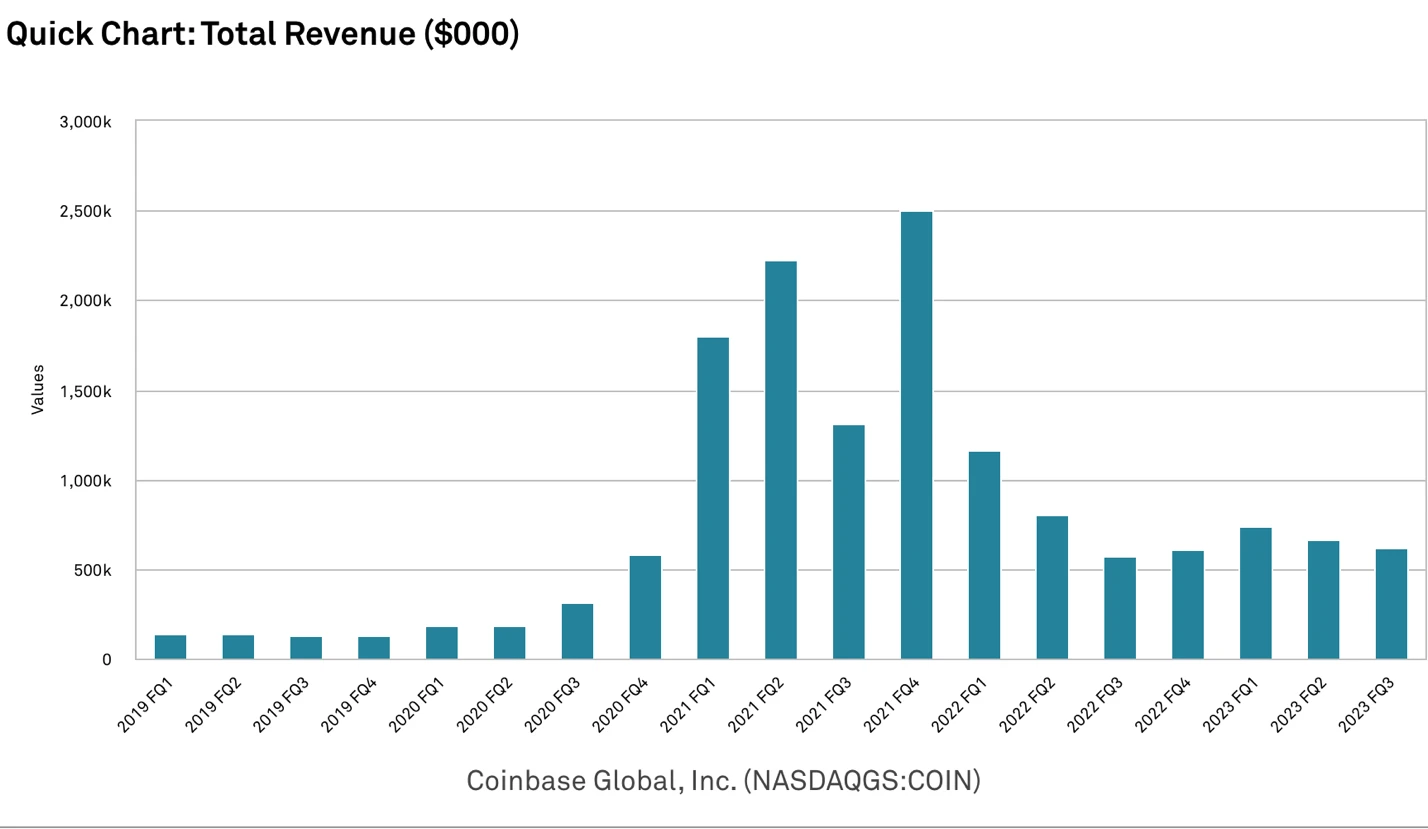
Source: Capital IQ
Coinbase achieved revenue of 674 million in Q3 2023. Looking at the breakdown of revenue by item, transaction revenue and subscription/service revenue are still the main sources of revenue. Ancillary business grows with the growth of transaction revenue. However, it can be seen that transaction revenue in Q3 and Q4 of 2022 respectively accounted for 50% of the total revenue. 61%, 52%, Q1 in 2023 will account for 48%, and Q3 will drop to 43%. The development of other businesses such as Subscription and services has also brought considerable revenue to Coinbase and its proportion is growing.
Trading revenue will show explosive growth in the bull market, and will show a downward trend in the bear market. On the contrary, subscription services and other businesses will see stable growth in the bear market. The bull market will be accompanied by the growth of trading revenue.
Business income classification

trading income
Trading revenue was once Coinbases main source of revenue, generating $288 million in the third quarter, but is now surpassed by subscription and services revenue ($334 million): Coinbase makes money by buying and selling cryptocurrencies. It usually depends on the transaction value or may depend on regular income. Spread: This is the difference between the buying and selling price of a cryptocurrency. Conversion fees: These fees convert one cryptocurrency to another and arise from the company’s revenue stream from trading. OTC Trading: This service is intended for institutional buyers and traders with large transactions or high volumes. Leveraged Trading: It also allows users to borrow money from the platform. It involves interest and borrowing fees paid by users. Payment processing fees: It also allows users to make payments from its platform using cryptocurrencies.
Subscription and service revenue
Coinbase offers managed subscription services including Coinbase Pro, Coinbase Prime, and Coinbase Custody.
Coinbase Pro is an advanced trading platform for professional and institutional investors. It offers some free features as well as a premium subscription for premium features. Designed specifically for institutional investors, Coinbase Prime offers enhanced trading capabilities, dedicated account management and access to liquidity solutions. Coinbase Securities typically provides institutional clients with secure custody solutions for storing cryptocurrencies. It also provides insurance coverage for digital assets. In addition, subscription and service income also includes stable currency income, block rewards, interest income, etc.
Coinbase’s subscription and service revenue in the third quarter of 2023 was $334 million, and it accounted for 49.55% of total revenue in the third quarter of 2023.
Other income
Coinbases other revenue comes from the following channels: Coinbase Commerce; Coinbase Cards; Interest Income; Institutional Services; Other Products and Services. Q3 in 2023 will account for 7.5% of total revenue, and the proportion will gradually increase.
In terms of regional revenue, although Coinbase has customers in more than 100 countries, the largest concentration is in the United States, accounting for about 40%, followed by the United Kingdom/Europe, accounting for about 25%, but the revenue from the United States will account for 20% of the total revenue from FY 2019 to 2022. The proportions are 78%, 76%, 81% and 84% respectively, which are much larger than other regions. In August this year, Coinbase announced its entry into the Canadian market, but growth in other regions will be limited by the local regulatory environment and competition from local exchanges.
2. Profit breakdown
Coinbases overall gross profit margin is very high, which is the main feature of SaaS companies. The gross profit margin in Q3 2023 is 85%. The main profits are still distributed in the above-mentioned transaction revenue and subscription services. The MEV income from the Staking business and the income from USDC are reflected in this; the net profit increased by bond repurchase reached US$81.6 million, increasing the net profit margin, which was the most influential change in the third quarter.
Staking business and Base MEV income
Coinbase is the only Sequencer of Base. Because of this, Coinbase can obtain all the priority gas profits caused by sorting from the Base chain.
According to L2 revenue = L2 handling fee – L1 data storage fee – L1 verification cost
Based on the current accumulated fees of Base to back-estimate the sorting fee, it is estimated that half of the 546 w minus 354 w can be given to Coinbase, which is 100 w US dollars (but in reality Coinbase relies on charging 25% -35% staked ETH commission as income)
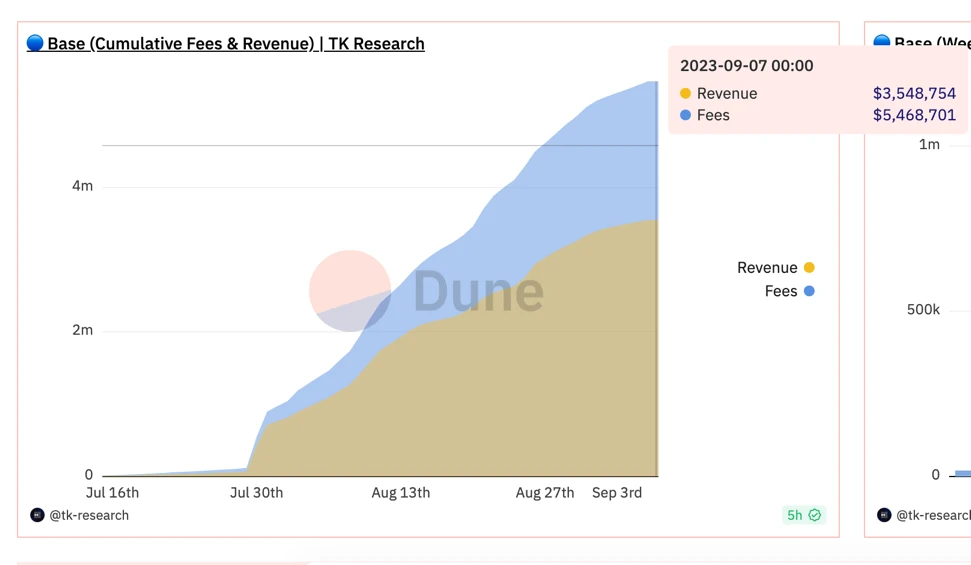
The revenue brought by the Base chain to Coinbase reaches 1 million (if the actual absolute value charged by Coinbase is calculated, it will be smaller). Looking at the number of ETH staked by Coinbase, it ranks first among all CEXs, with a market share of 8.6% and a total ranking of Second to Lido, the realized ETH income is 187k, about 300mln US dollars, of which Coinbase charges a commission of 25% -35%, that is, about 100 million US dollars of income comes from the Staking business.
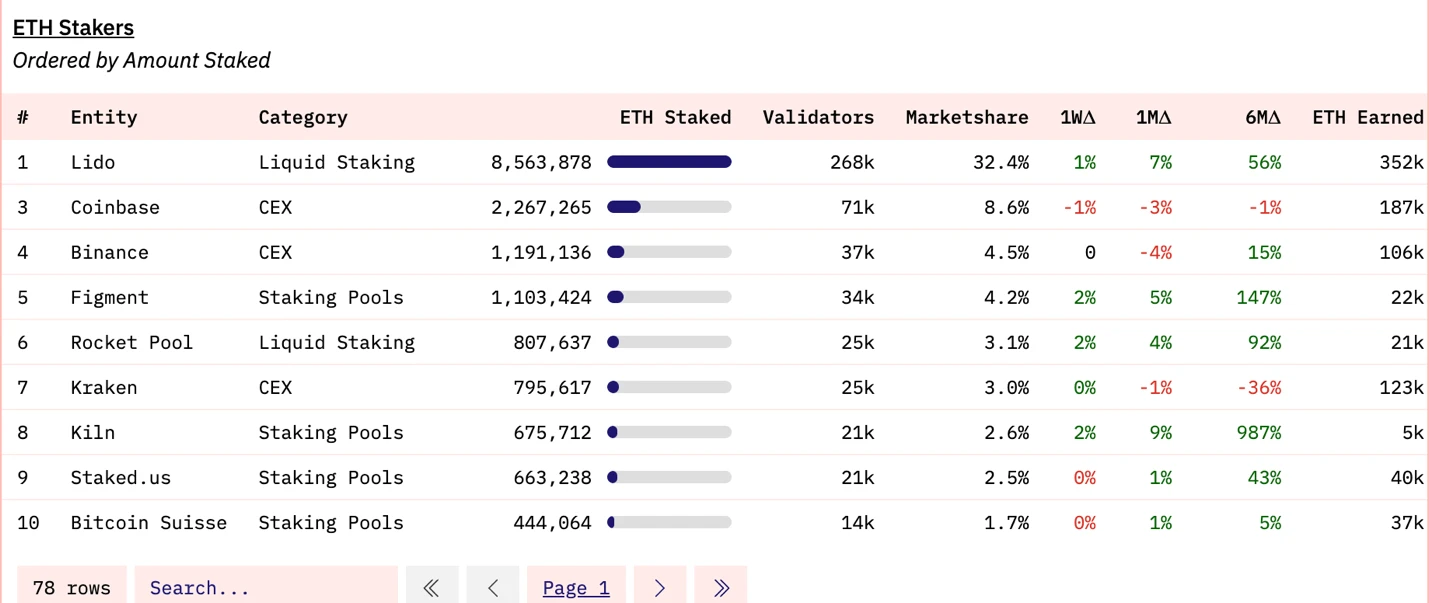
Coinbase EBITDA remains at about 40% of revenue, a ratio that will decrease when main revenue fails to grow due to cycles and macros and external costs such as regulatory penalties increase. As the bull market approaches the EBITDA/revenue ratio will increase accordingly.
USDC business
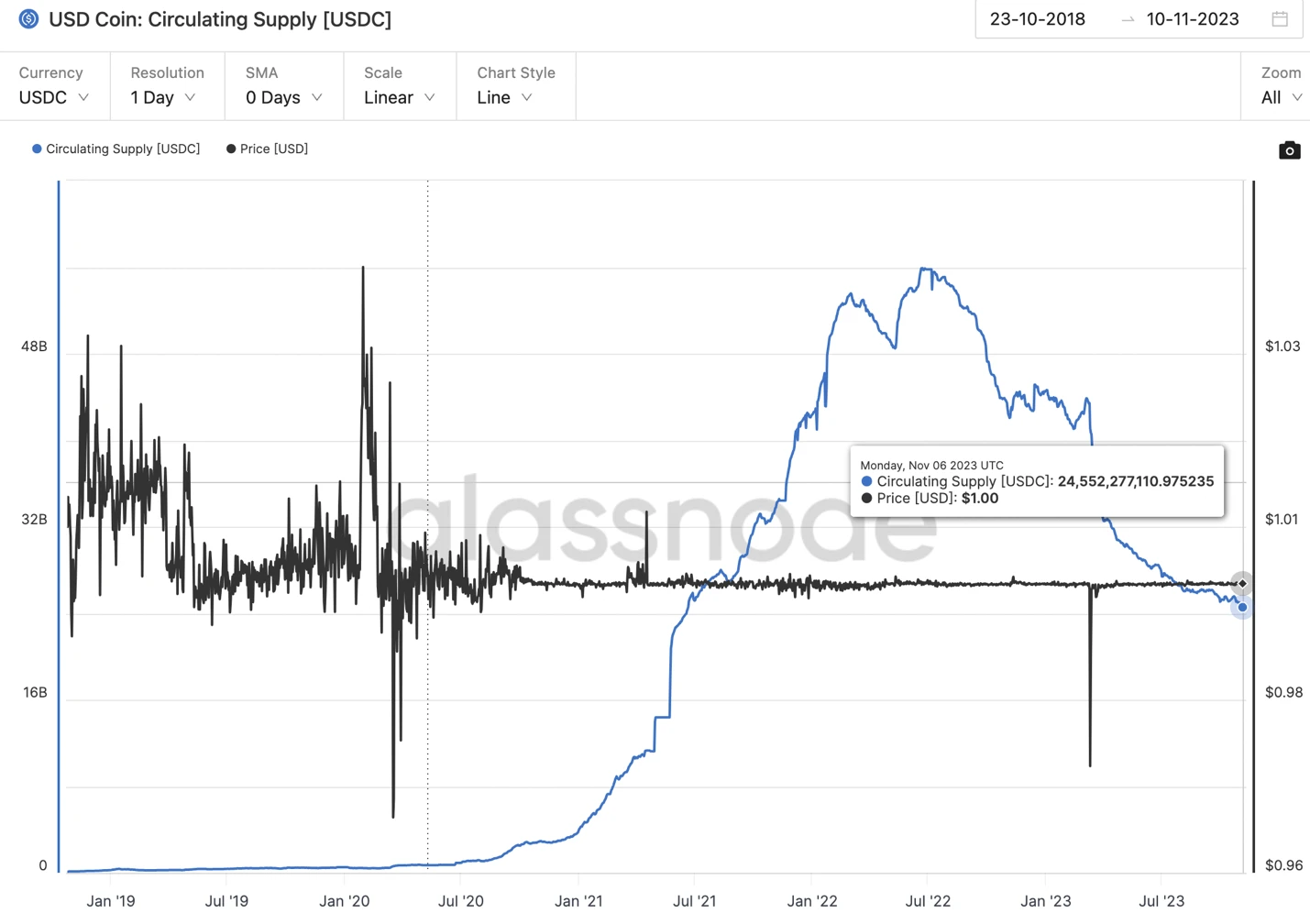
The Coinbase platform currently holds 132 mln USDC. Due to the banking crisis in Q1, Silicon Valley Bank failed to mint USDC significantly, and Binance exchanged USDC for another stable currency, causing the market value of USDC to decline. However, Coinbase CEO Bria believes that regulatory risks in the United States may intensify. People think that USDC is more relevant to the United States than other stable coins such as Tether, which will also make USDC face difficulties in the short term.
The overall market value of USDC has declined, and the current stablecoin market share is only 21%. Perhaps this is also the reason why it introduced Coinbase as an investor and plans to launch USDC on six new blockchains between September and October to prevent share. Strategic considerations for continued decline. It’s clear that Coinbase values its stablecoin business and needs to capture as much revenue as possible from its stablecoin business.
3. Cost
In January 2023, the Company announced and completed a reorganization affecting approximately 21% of the Companys employee base as of December 31, 2022 (the 2023 Reorganization). The 2023 restructuring is designed to respond to market conditions that continue to impact the crypto economy and ongoing business priorities to manage the companys operating expenses. As a result, approximately 950 employees across various departments and locations were laid off. As part of their layoffs, they received separation compensation and other personnel benefits.
Cash payments related to this restructuring were substantially completed during the second quarter of 2023, with the remainder expected to be paid by December 31, 2023. The 50% reduction in operating documents caused by the reduction in labor costs is also one of the important reasons why Coinbase has exceeded expectations for three consecutive quarters in Q1, Q2, and Q3 this year.
In terms of operating cost expenses, on March 3, 2023, the Company completed the acquisition of One River Digital Asset Management, LLC. (ORDAM), by acquiring all of the issued and outstanding membership interests in ORDAM. ORDAM is an institutional digital asset management company registered as an investment adviser with the U.S. Securities and Exchange Commission (SEC). The company believes that this acquisition is consistent with the companys long-term strategy and can provide more opportunities for institutions to participate in the crypto economy. The total consideration paid in the acquisition was $96.8 million.

Source:Capital IQ
4. Borrowing costs
In August and September 2023, Coinbase Chief Financial Officer Alesia Haas led a buyback of Coinbases 2031 debt for $263 million, but only spent $177 million. That is, most of the profits were used to repurchase convertible senior notes (1 billion issued in September 2021, due in October 2031), and the corresponding net income from the disappearance of long-term debt amounted to US$81.6 million.
On August 7, 2023, Coinbase announced a cash offer to buy at a price of 64.5 cents (before August 18) or 61.5 cents (after August 18 but before expiration on September 1) It has up to $150 million in senior unsecured notes due 2031. Coinbase will fund the deal through its operating cash flow. The tender offer was to repurchase $645 million of 0.5% convertible senior notes due 2026 at a 29% discount in June 2023 for approximately $45.5 million in cash. Considering Coinbase has ample liquidity and no near-term refinancing risk, the deal is believed to be profitable and will not create a cash crisis for Coinbase. The deal will also further increase excess cash reserves against debt through the discount provided and will reduce its annual interest expense by approximately $540W.
In theory, Coinbases proactive use of cash tender offers to purchase part of future maturing debt and reduce its debt burden can help reduce the companys future debt interest expenses and improve financial stability. Enhance market confidence: An improvement in the companys debt repayment ability and financial strength may increase market confidence in the company, help increase stock prices and credit ratings, and also help reduce borrowing costs.
Four. Valuation
DCF analysis
To perform the discounted cash flow analysis, current D/V (67%) and E/V (33%) ratios were used based on Coinbases capital structure. The leveraged equity beta for Coinbase is calculated to be 3.15. Calculate the cost of equity using the CAPM model, assuming a market risk premium of 7% and a risk-free rate of 5.5%. Use the loan cost of the companys senior notes and combine it with an effective tax rate of 27% to arrive at the after-tax loan cost. The companys weighted average cost of capital (WACC) is obtained to be 23.58%.
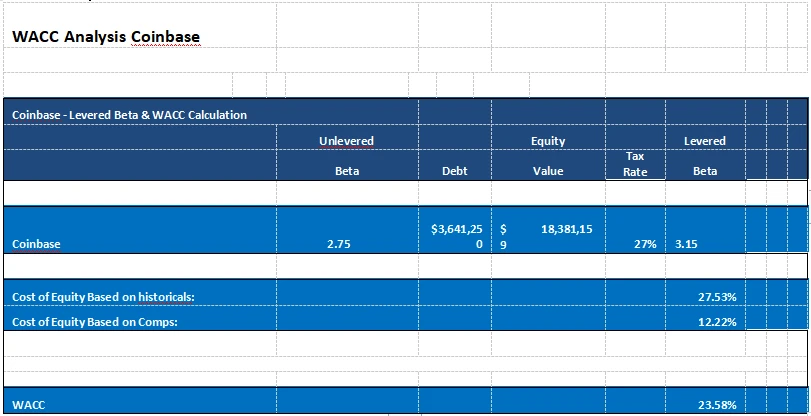
Given the current high interest rate environment, it is believed that these high levels may continue until a pullback in July next year. Therefore, the terminal values calculated in the DCF model are biased toward less conservative levels. The growth rate estimates for FY 2023-2025 are -5%, 10%, and 500% respectively.
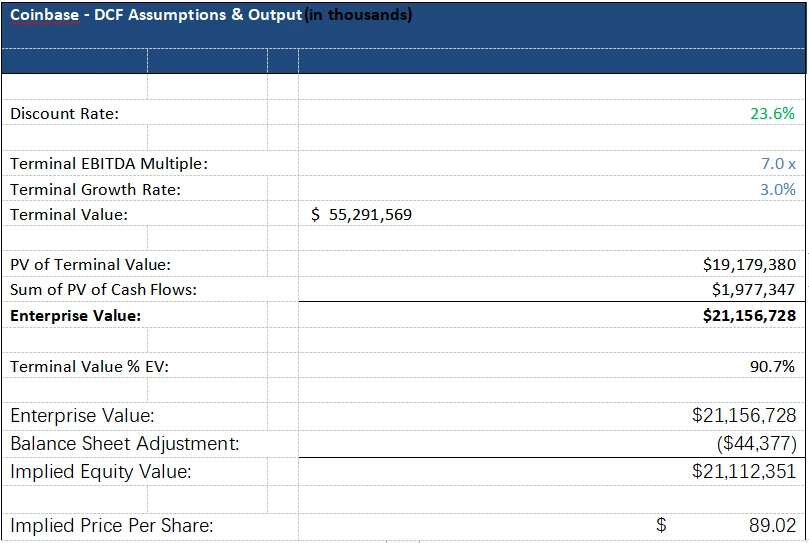
Valuation rationale and recommendations
The valuation shows that in the base scenario, the fair value of Coinbase is US$89, and the current price of US$74 is 16% undervalued; however, combined with the DCF valuation models higher sensitivity to business growth in the forecast fiscal year and terminal EV/EBITDA multiples, It should be considered based on the endogenous cycle of crypto market transactions and market sentiment. Short-term stock prices are being ignored by both the U.S. stock market and the crypto market and are facing downward pressure. The more practical operational advice is to sell in the next 12-month cycle and then in the future. Buy on a 24-month period, fair value is $89 when EV/EBITDA is 7x, and fair value is $170 when EV/EBITDA is 14x.
five. Risks - Regulatory Uncertainty
Coinbase is seeking to dismiss a lawsuit filed by the SEC in June in New York federal court against U.S.-compliant crypto trading platform Coinbase, Inc. and its parent company Coinbase Global, Inc., accusing the company of operating an unregistered exchange, brokerage and clearinghouse mechanism.
Highlights of the indictment
According to the Securities Exchange Act of 1934, the functions of brokers, exchanges and clearing agencies in the traditional securities market are separated, but the Coinbase platform merges the three functions and has not been registered with the SEC or obtained any Applicable Immunities. For years, Coinbase has defied regulatory structures and evaded disclosure requirements from Congress and the SEC.
Coinbase also offers two additional services to investors related to its operation as an unregistered broker. The first is Coinbase Prime (Prime), which forwards orders for crypto assets to the Coinbase platform or third-party platforms. The second is Coinbase Wallet, which provides access to liquidity outside of the Coinbase platform by routing orders to third-party crypto asset trading platforms.
Coinbase has always provided crypto-asset trading services as its main source of profit, but it has ignored that these assets may have security properties. In fact, starting in 2016, Coinbase made it clear that crypto-assets should be subject to securities regulations and positioned itself as a compliant platform in its marketing. Despite paying lip service to its willingness to comply with applicable laws, Coinbase has consistently allowed trading of cryptoassets that meet the Howey test criteria.
Since 2019, Coinbase has offered a staking service that allows investors to earn rewards by staking crypto assets, while Coinbase earns a commission of 25 – 35%. However, Coinbase has never registered with the SEC for the issuance and sale of staking projects, which deprived investors of important information about the scheme, harmed their rights and interests, and violated the registration provisions of the Securities Act of 1933.
The revenue generated by Coinbase ultimately flows to its parent company CGI, which is actually the actual controller of Coinbase. Therefore, CGI also violated the same exchange law provisions as Coinbase.
The SEC seeks a final judgment: (a) permanently prohibiting the defendants from violating relevant provisions of the securities laws; (b) ordering the defendants to disgorge illegal gains and pay prepaid interest; (c) impose a civil penalty on Coinbase and require it to be an investor appropriate or necessary equitable relief for the interests of the party. (Note: The ruling sought by the SEC against Binance also prohibits it from permanently engaging in financial industry-related business.)
Summarize
In summary, it is currently believed that Coinbase’s profit expectations are better than those in the first half of 2023, but profits will continue to be suppressed because the crypto market has not truly entered a bull market. However, due to the correct on-chain, derivatives development strategy, etc., its revenue and profit growth potential will be freed. Revenue growth that has not yet been fully priced in: 1) International sites and derivative products will bring substantial revenue growth after they are officially launched. 2) The continued growth of the staking business, including the sorting income of the base chain (and other chains); the income of the staking business; the incremental use of other coinbase products and services (wallets, etc.) brought by users on the chain; 3) the potential of USDC The recovery in volume will bring about an increase in reserve interest income and fees incurred in distribution; however, due to the strong correlation with the crypto market, it is expected that the high inflation and high interest rate environment suitable for crypto growth will continue in the 8-12 months when the macro is not optimistic. Against this background, the transaction income of the main business will not increase significantly. But the growth rate in the ensuing bull market would exceed the 515% gain in 21.
The valuation shows that in the base scenario, the fair value of Coinbase is US$89, and the current price of US$74 is 16% undervalued; however, combined with the DCF valuation models higher sensitivity to business growth in the forecast fiscal year and terminal EV/EBITDA multiples, It should be viewed in conjunction with the endogenous cycle of crypto market transactions and market sentiment. Short-term stock prices have rebounded significantly under the recent double situation of the US stock market and the crypto market emerging from the calf. A more practical operational recommendation is to buy when the short-term macro benefits are being priced in. , when P/B exceeds the high in July this year, the risk of overvaluation needs to be considered. At EV/EBITDA 7x, fair value is $89, and at 14x, fair value is $170.
appendix
Compliance status
Coinbase CEO believes that the MiCA bill passed in Europe, but the United Kingdom, Singapore, Brazil, every financial center is actively working to pass legislation, and other countries are ahead of the United States in this regard.
Coinbase is also working to provide regulatory clarity to the entire industry. One of the biggest issues hindering the adoption of this technology is the lack of clear rules and enforcement regulations so far in the United States. While the rest of the world has made significant progress in embracing encryption and web3 technologies and enacting clear legislation, the United States has struggled to follow suit. Coinbase has an important role to play here. When the SEC declined to engage in rulemaking, opting instead to pursue an enforcement regulatory approach, Coinbase leveraged the courts to help bring regulatory clarity to the U.S. and help create case law. Coinbase has also been actively involved in Congress, where it has seen bipartisan support for crypto legislation passed.
Over the past two months, the House Financial Services Committee and House Agriculture Committee passed the landmark Crypto Market Structure Act (FIT 21) and Stablecoin Act with bipartisan support. The bills will be brought to the full House for a vote later this year and from there to the Senate. Coinbase pledges to help ensure the U.S. passes crypto legislation and isn’t left behind. A nationwide mobilization of crypto users has also begun to ensure their voices are heard in Coinbase’s democracy. One in five Americans now uses cryptocurrency — a higher percentage than holding a union card. So far, the “Pro-Crypto” movement has attracted approximately 60,000 crypto advocates covering 435 congressional districts. Coinbase’s political influence is also growing, following an in-person gathering in August with representatives from Senator Gillibrand’s office, Mayor Adams’ office, and Governor Hokull’s office, as well as hundreds of crypto enthusiasts.
Coinbase is subject to various anti-money laundering and counter-terrorism financing laws, including the U.S. Bank Secrecy Act (BSA) and similar foreign laws and regulations. In the United States, as a money services business registered with the U.S. Fiscal Crime Enforcement Network (FinCEN), the BSA requires the firm to develop, implement and maintain a risk-based anti-money laundering program, provide an anti-money laundering training program, report suspicious activities and transactions to FinCEN, Comply with certain reporting and recordkeeping requirements and collect and maintain information about its customers. In addition, the BSA requires it to comply with certain customer due diligence requirements as part of its anti-money laundering obligations, including the development of risk-based policies, procedures and internal controls reasonably designed to verify customer identities.
Coinbase has implemented a compliance program designed to prevent its platform from being used to facilitate money laundering, terrorist financing and other illicit activities, whether domestically or with countries on the Office of Foreign Assets Control’s (OFAC’s) Designated List , individuals or entities to conduct transactions.
In the United States, Coinbase has obtained the licenses required to operate as a money transmitter or equivalent money transmitter in the states in which it operates, including the District of Columbia and Puerto Rico. Additionally, it has obtained a BitLicense from the New York State Department of Financial Services (NYDFS).
Outside the United States, Coinbase has received a license from Germany’s federal financial supervisory authority to provide custody and trading of crypto assets. The company is also registered in Japan as a crypto-asset trading service provider, providing crypto-assets and first-party payment services, covering crypto-assets and first-party payment services, according to registration with the Kanto Local Finance Bureau of the Ministry of Finance of Japan. In Singapore, the company operates under the Payment Services Act and is overseen by the Monetary Authority of Singapore (MAS). The company is currently in preliminary approval status and needs final approval from MAS to become a major payer. Under these licenses and registrations, it is subject to a wide range of rules and regulations, including anti-money laundering, safeguarding of client assets and funds, regulatory capital requirements, fitness and due management, operational controls, corporate governance, client disclosures, reporting and records save.
Coinbase Custody Trust Company, LLC, a subsidiary of Coinbase, is a New York State-approved limited purpose trust company subject to regulation, review, and supervision by NYDFS. NYDFS regulations impose numerous requirements on various compliance requirements, including, but not limited to, operational restrictions regarding the nature of cryptoassets that may be held under custody, capital requirements, BSA and anti-money laundering program requirements, related party transaction restrictions, and notification and reporting Require.
Coinbase serves customers through an electronic money institution authorized by the UK Financial Conduct Authority and the Central Bank of Ireland. The Company complies with the rules and regulations applicable to the European electronic money industry, including those relating to fund custody, corporate governance, anti-money laundering, disclosure, reporting and inspections.
Coinbase has established a set of policies and practices for evaluating every crypto asset it considers for listing or custody and is a founding member of the Crypto Ratings Council. Coinbases brokerage business is operated by Coinbase Capital Markets and Coinbase Securities, which are registered as broker-dealers with the SEC under the Securities Exchange Act of 1934, as amended (Exchange Act).
Coinbase Q3 Earnings Update
Overall, Coinbase beat expectations for third-quarter earnings and revenue, but missed expectations in terms of total trading volume. The financials were more similar to Q2 (adjusted loss per share in Q3 was $0.01, which was better than the FactSet estimate of a loss of $0.55 per share, marking the third consecutive quarter that Coinbase has beaten earnings estimates). Total revenue for the quarter was $674.1 million, beating estimates of $650.9 million.
Coinbase had a strong third quarter despite shrinking trading volumes due to poor markets, including:
1) Repurchased notes at a discount, achieving a net profit of 81.6 million yuan and sufficient cash flow
Coinbase CFO Alesia Haas led a buyback of $263 million of Coinbase’s 2031 debt, but only spent $177 million. That is, most of the profits will be used to repurchase convertible senior notes (1 billion issued in September 2021, due in October 2031). This transaction will occur from August to September 2023, and the corresponding net loss of long-term debt will be Revenues amounted to US$81.6 million. This is very strategic and shows that Coinbase is not bothered by cash flow.
2) Continue to vigorously develop on-chain business, international stations and derivatives business
Coinbases derivatives exchange is indeed still in its early stages. Q2-Q3 actually only launched an API beta version and only had a few customers. Therefore, some of the next steps Coinbase will take include integrating it into retail applications. In August, its wholly-owned subsidiary CFM successfully obtained regulatory approval from the National Futures Association (NFA), a self-regulatory organization designated by the U.S. Commodity Futures Trading Commission (CFTC), to become a futures broker (FCM), allowing it to sell qualified U.S. customers Offers federally regulated cryptocurrency futures trading. The official launch of the international station and derivatives products will bring substantial revenue growth.
Looking ahead to the fourth quarter, with trading revenue of approximately $105 million in October, Coinbase expects to achieve meaningful positive adjusted EBITDA in 2023, slightly above its previous target of increasing full-year 2023 EBITDA. There are adjustments.
Note: This article only represents the author’s personal views and does not constitute investment advice.










